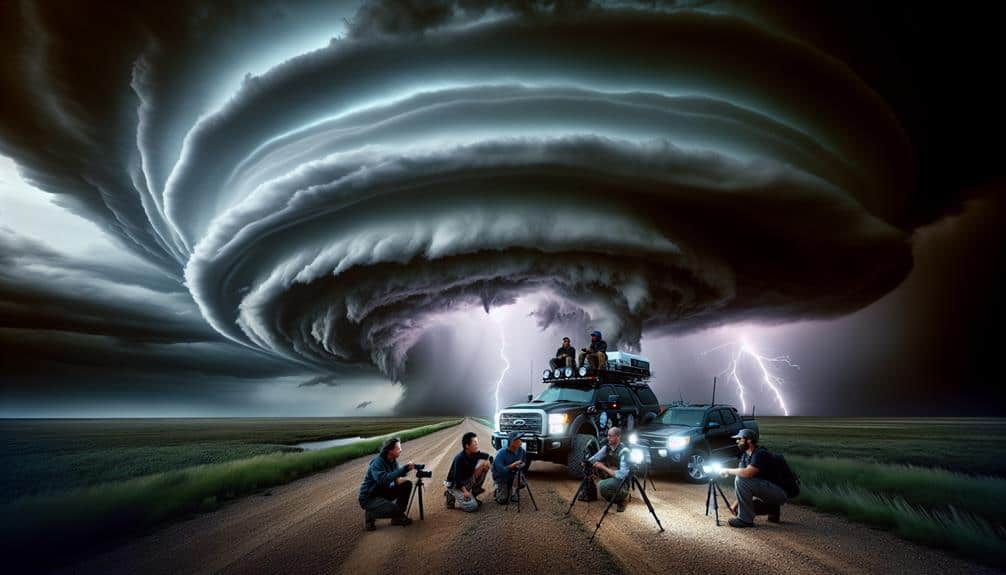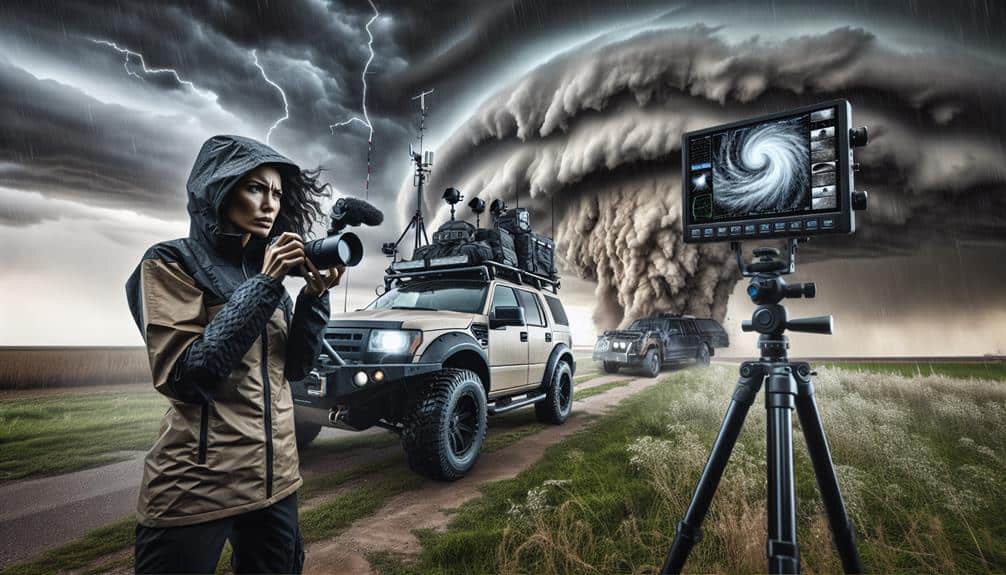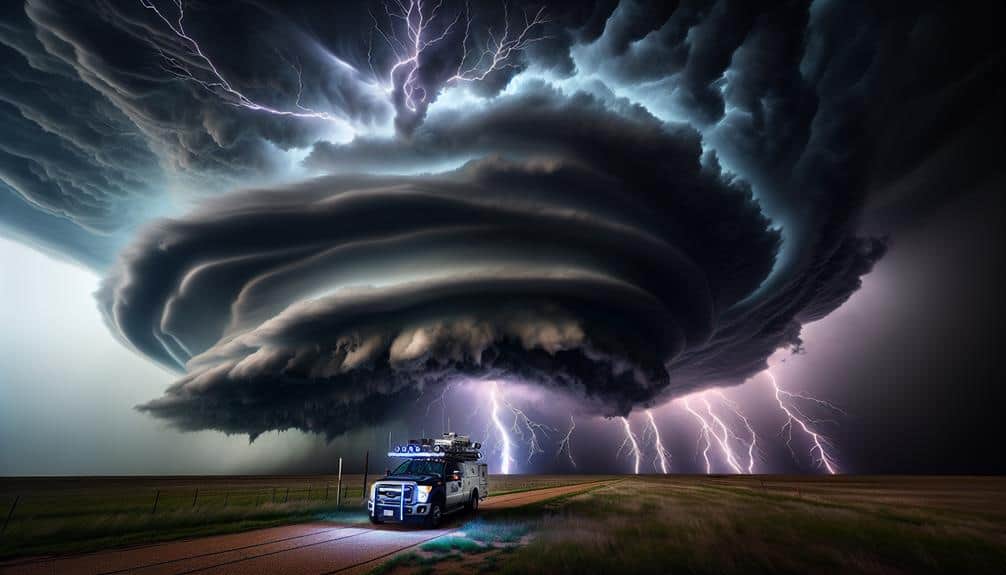We prioritize high-definition radar systems for real-time storm tracking and GPS tools for precise navigation. Safety's vital, so we pre-plan escape routes and identify storm shelters. In solo chases, integrating storm motion vectors with GPS-mapped routes boosts efficiency. For group dynamics, effective communication, predefined roles, and staggered vehicle formations guarantee thorough coverage. Using weather radios and emergency kits keeps us informed and prepared. Mastering these strategies elevates our storm-chasing proficiency, enabling us to capture supercell phenomena thoroughly. To dive deeper into these methods and more, stick around.
Key Points
- Utilize high-definition radar systems for real-time storm data and precise tracking.
- Employ GPS devices and detailed maps to navigate accurately relative to storm movements.
- Conduct rigorous risk assessments and pre-plan escape routes for safety.
- Maintain effective communication through two-way radios and predefined signals if chasing in groups.
Understanding Supercell Storms
Supercell storms, characterized by their rotating updrafts known as mesocyclones, are the most powerful and complex type of thunderstorms. When we talk about storm structure, terminology such as the 'updraft' and 'downdraft' becomes essential.
The updraft is where warm, moist air rises and rotates, forming the mesocyclone. This rotation is driven by wind shear, which is the change in wind speed and direction with height. The downdraft, on the other hand, is where cooler air descends, contributing to precipitation and potentially severe weather events.
To understand supercell formation, patterns of atmospheric conditions must be analyzed. Warm, moist air at the surface, combined with cold, dry air aloft, creates instability—a key ingredient. Wind shear then organizes the storm into a rotating structure.
Observations show that supercells can sustain themselves for hours, given the right conditions. Data indicates that these storms often follow specific patterns, forming along drylines or frontal boundaries where contrasting air masses meet.
For those of us seeking the thrill of storm chasing, comprehending these details isn't just academic; it's necessary. Knowing how supercells form and behave empowers us to make informed, safe decisions while chasing these awe-inspiring phenomena.
Essential Gear and Equipment
When preparing for a storm chase, we must equip ourselves with high-definition radar systems, GPS devices, and reliable communication tools to accurately track and navigate supercell storms. High-definition radar systems provide real-time data on storm structure and movement, allowing us to make precise decisions.
GPS trackers are critical for pinpointing our exact location relative to the storm, ensuring we stay within safe distances while capturing best footage.
In addition, camera gear is essential for documenting the chase. A DSLR or mirrorless camera with a fast lens is ideal for capturing lightning strikes and detailed cloud formations. A sturdy tripod guarantees stability in windy conditions, and extra batteries and memory cards are a must.
A weather radio is indispensable for receiving up-to-the-minute weather updates and emergency alerts. This helps us stay informed about shifting storm dynamics.
Our emergency kit should include first aid supplies, water, non-perishable food, and basic tools. This kit guarantees we're prepared for any unexpected situations during the chase.
Reliable communication tools, such as satellite phones, guarantee we're never out of touch, even in remote areas. With this gear, we're prepared to chase supercells with both precision and freedom.
Safety Precautions
While our gear ensures we can track and document supercells effectively, adhering to strict safety protocols is crucial to protect ourselves during the chase. Our first step involves rigorous risk assessment. We continuously monitor storm trajectories and severity using advanced radar systems and real-time satellite data. Equipping ourselves with reliable weather radios guarantees we receive immediate updates on storm developments and emergency alerts, essential for making split-second decisions.
Understanding and identifying storm shelters along our route is non-negotiable. We pinpoint potential shelters such as reinforced buildings or storm cellars within our operational area. This proactive measure allows us to quickly seek refuge if a tornado or severe hail becomes imminent.
Additionally, our emergency protocols dictate that we always have a pre-planned escape route, ensuring we can retreat safely from rapidly changing storm conditions.
Furthermore, our vehicles are outfitted with essential survival gear, including first aid kits, water, and non-perishable food. This preparation is crucial should we become stranded.
Solo Chasing Techniques
Tackling the complexities of solo chasing demands a meticulous approach that combines advanced technology, precise timing, and a deep understanding of storm dynamics. We start by integrating real-time storm tracking tools. Leveraging radar data, satellite imagery, and storm prediction models enhances our situational awareness.
Apps like RadarScope and GRLevel3 provide high-resolution radar data essential for pinpointing storm locations and predicting their paths.
Road navigation is another crucial component. We rely on up-to-date GPS systems and detailed maps to chart the safest and most efficient routes. Google Maps, combined with offline navigation apps like OsmAnd, ensures we remain on course even in areas with poor connectivity. It's vital to regularly update our maps and GPS firmware to avoid unexpected road closures or construction.
Timing our movements is equally important. By analyzing storm speed and direction, we can position ourselves optimally—close enough to observe but far enough to remain safe. We use storm motion vectors and speed calculations to make real-time adjustments, ensuring we stay ahead of the storm without encountering its most dangerous elements.
This precision-driven approach maximizes our observation opportunities while maintaining safety and freedom.
Group Chasing Dynamics

In group chasing dynamics, effective communication and coordination are crucial to guarantee safety and maximize data collection efficiency. We must utilize strong communication tactics and real-time data sharing to maintain situational awareness.
Group coordination involves assigning specific roles such as navigator, driver, and storm spotter to make sure each member focuses on their tasks. By employing strategic positioning, we can cover multiple vantage points, increasing our chances of capturing valuable storm data.
Precise, unambiguous communication is critical. We rely on two-way radios and GPS tracking to share real-time updates on storm movement and road conditions. This ensures everyone remains informed and can adapt quickly to shifting scenarios. Moreover, we use predefined code words and signals to streamline communication, minimizing confusion during high-pressure situations.
Strategic positioning isn't just about location but timing. We position our vehicles in a staggered formation, ensuring no one vehicle blocks another's view. This formation provides thorough coverage and enhances storm spotting accuracy. We also maintain a safe distance from the storm to avoid hazards while still obtaining high-quality data.
Frequently Asked Questions
What Are the Best Online Resources for Real-Time Storm Tracking?
For the best online resources for real-time storm tracking, we recommend storm chasing forums and weather radar apps. These platforms provide precise observations, technical terminology, and data-driven insights, allowing us to stay informed and maintain our freedom.
How Can I Identify the Best Locations for Viewing Supercells?
To identify the best locations for viewing supercells, we analyze weather patterns and seek topographic advantages like open plains. Precise observations and data-driven insights help us choose spots maximizing visibility and safety while chasing freedom.
What Are the Legal Considerations for Storm Chasing?
Sailing through the stormy waters of legal regulations and insurance requirements, we must guarantee our adventure stays within the law's boundaries. Let's get our paperwork in order and comprehend local ordinances to chase freely and safely.
How Do I Maintain Vehicle Performance During Long Chases?
We prioritize vehicle maintenance and storm safety by performing regular checks on tires, brakes, and fluids. Our equipment essentials include spare parts and tools. Emergency preparedness means having first-aid kits, GPS devices, and communication gear ready.
What Are the Most Common Mistakes Beginners Make in Storm Chasing?
Surprisingly, we often see beginners neglecting safety precautions and lacking proper equipment. They underestimate the storm's speed and unpredictability, leading to dangerous situations. Prioritizing safety and investing in reliable gear can't be emphasized enough.


